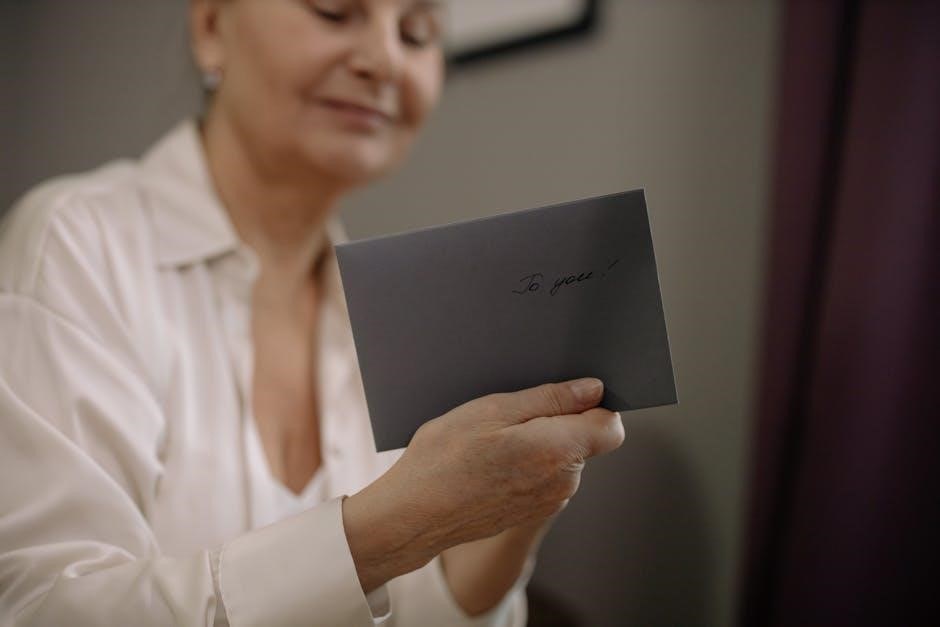
fannie mae gift letter pdf
Get your Fannie Mae gift letter PDF instantly! Free download, editable template, and easy-to-follow guide. Perfect for mortgage applications!
A Fannie Mae Gift Letter is a document provided by donors to outline the details of a monetary gift for mortgage purposes. It ensures the funds are a gift, not a loan, crucial for mortgage approval.
What is a Fannie Mae Gift Letter?
A Fannie Mae Gift Letter is a written statement provided by a donor to confirm that funds given to a borrower are a gift and not a loan. It is required for mortgage transactions when gift funds are used for down payments, closing costs, or other eligible expenses. The letter must include the donor’s name, relationship to the borrower, amount of the gift, and a clear statement that no repayment is expected. It also specifies the source of the funds and acknowledges that the gift complies with Fannie Mae’s guidelines. This document is essential to ensure transparency and prevent misrepresentation of the funds’ nature, helping lenders assess the borrower’s financial situation accurately. The letter must be signed by the donor and, in some cases, notarized to validate its authenticity.
Importance of a Gift Letter in Mortgage Transactions
A Fannie Mae Gift Letter plays a pivotal role in mortgage transactions by ensuring transparency and legitimacy in the use of gift funds. It confirms that the funds provided are a genuine gift and not a loan, which could impact the borrower’s debt-to-income ratio. This verification is critical for lenders to assess the borrower’s financial stability and creditworthiness. By providing a clear and documented source of funds, the gift letter reduces the risk of misrepresentation and fraud. It also helps lenders comply with regulatory requirements and ensures that the transaction adheres to Fannie Mae’s guidelines. Ultimately, the gift letter facilitates smoother mortgage processing and enhances the likelihood of loan approval when gift funds are involved in the purchase of a home.

Understanding Fannie Mae Guidelines
Fannie Mae guidelines establish rules for mortgage lending, ensuring safe and sustainable lending practices; They provide clear criteria for loan eligibility, including the use of gift funds, to protect both lenders and borrowers. These guidelines are essential for maintaining the integrity of the mortgage market and facilitating affordable homeownership. By adhering to Fannie Mae’s standards, lenders can offer competitive loan products while minimizing risks. Borrowers also benefit from clear expectations and a streamlined process. Understanding these guidelines is crucial for navigating the mortgage application process effectively.
Overview of Fannie Mae and Its Role in Mortgages
Fannie Mae, officially known as the Federal National Mortgage Association (FNMA), is a government-sponsored enterprise (GSE) established in 1938 to stabilize the U.S. mortgage market. Its primary mission is to make mortgages more accessible and affordable for low- and middle-income Americans. Fannie Mae achieves this by purchasing and securitizing mortgage loans from lenders, freeing up capital for lenders to issue more loans. It operates in the secondary mortgage market, ensuring liquidity for lenders and providing standardized mortgage products. Fannie Mae’s guidelines and policies play a critical role in shaping mortgage lending practices, including the acceptance of gift funds for down payments. By adhering to Fannie Mae’s standards, lenders can offer competitive loan terms while managing risk effectively. Fannie Mae’s efforts are central to promoting sustainable homeownership and maintaining stability in the housing market.
Fannie Mae’s Requirements for Gift Funds
Fannie Mae requires that gift funds used for a down payment or closing costs meet specific criteria. The funds must be a bona fide gift, meaning they are transferred with no expectation of repayment. Donors must be acceptable sources, such as family members, employers, or non-profit organizations. A gift letter is mandatory, detailing the donor’s relationship to the borrower, the amount gifted, and the source of the funds. The letter must also state that the funds are a gift, not a loan. Additionally, Fannie Mae requires documentation, such as bank statements, to verify the transfer of funds. Generally, gift funds can cover up to 100% of the down payment for eligible borrowers, provided all guidelines are met. These requirements ensure transparency and prevent misuse of gift funds in mortgage transactions.
Eligible Sources of Gift Funds
Fannie Mae allows gift funds from specific, approved sources to be used for down payments or closing costs. Eligible donors include family members, such as parents, siblings, or spouses, as well as employers or non-profit organizations. Gifts from unrelated individuals, such as friends, are generally not permitted unless a demonstrated, existing relationship can be documented. Additionally, gifts from government agencies or public entities, such as down payment assistance programs, are acceptable. The donor must provide documentation, such as bank statements, to verify the source and transfer of funds. Gifts from entities with a financial interest in the transaction, like the seller or real estate agent, are prohibited. Fannie Mae requires that all gift funds be properly documented to ensure compliance with their guidelines and to prevent any misuse of funds.

Structure of a Fannie Mae Gift Letter
A Fannie Mae Gift Letter outlines the donor, recipient, gift amount, source of funds, and a statement confirming the gift is not repayable in writing.
Key Components of a Gift Letter
A Fannie Mae Gift Letter must include the donor’s and recipient’s full names, their relationship, the exact gift amount, and the source of the funds. It should also state that the gift is not repayable and is solely for the purpose of purchasing or refinancing a home. The letter must be signed and dated by the donor, confirming the gift’s legitimacy. Additionally, it should clarify that no expectations of repayment exist, ensuring compliance with Fannie Mae’s guidelines. Properly documenting these elements ensures the gift funds are accepted in a mortgage transaction without delays or complications.

Sample Fannie Mae Gift Letter PDF
A sample Fannie Mae Gift Letter PDF serves as a guide for drafting a proper gift letter. It outlines the structure, content, and formatting required by Fannie Mae for mortgage transactions. The template typically includes sections for the donor’s and recipient’s full names, their relationship, the gift amount, the source of funds, and a statement confirming the gift is not repayable. It also includes placeholders for signatures, dates, and donor contact information. Using a sample PDF ensures compliance with Fannie Mae’s guidelines, helping to avoid errors and delays. The sample is widely available online and can be customized to fit specific transaction details, providing a clear and professional format for presenting gift funds in a mortgage application.
How to Fill Out the Gift Letter Correctly
To fill out the Fannie Mae Gift Letter accurately, start by including the donor’s and recipient’s full names, addresses, and relationship. Clearly state the gift amount and its source. Specify that the funds are a gift, not a loan, and that no repayment is expected. Both parties must sign and date the letter, and it may need to be notarized. Include the property address and loan details if applicable. Ensure all information is legible and complete to avoid delays. Double-check for errors and adherence to Fannie Mae’s guidelines before submission. Proper completion ensures compliance and smooth processing of the mortgage application.

Eligibility Criteria for Gift Letters
A Fannie Mae Gift Letter is eligible for borrowers using gift funds for down payments or closing costs, provided the donor is a related party or approved source.
Who Can Give a Gift for Fannie Mae Loans?
A Fannie Mae Gift Letter allows gifts from family members, such as parents, siblings, or spouses, as well as other relatives like aunts, uncles, or cousins. Friends and fiancés may also contribute, but they are subject to stricter scrutiny. The donor must provide documentation, such as a gift letter, to confirm the funds are a gift and not a loan. The donor’s financial ability to give the gift may also be reviewed. Gifts from non-relatives or unrelated parties are typically not permitted unless specific conditions are met. Fannie Mae requires the donor to sign the gift letter, verifying the funds are a bona fide gift with no expectation of repayment. This ensures compliance with mortgage lending regulations and avoids potential issues in the loan approval process.
Who Can Receive a Gift for Fannie Mae Loans?
A Fannie Mae Gift Letter enables eligible borrowers to receive financial gifts to assist with their mortgage down payment or closing costs. The recipient must be the borrower or co-borrower on the loan, and the gift must be used for a primary residence, second home, or investment property. Gifts are typically allowed for first-time homebuyers or repeat buyers, provided they meet Fannie Mae’s guidelines. The recipient must also sign the gift letter, acknowledging the funds are a gift and not a loan. This ensures transparency and compliance with lending requirements.
Additionally, the recipient must provide documentation, such as bank statements, to verify the gift funds are sourced from an eligible donor. Fannie Mae prohibits gifts from parties with an interest in the transaction unless they are related to the recipient.
Restrictions on Gift Letters
Fannie Mae Gift Letters are subject to specific restrictions to ensure the funds are a genuine gift and not a loan or exchange. Gifts cannot come from parties with an interest in the transaction, such as sellers, real estate agents, or lenders. Additionally, the funds must be sourced from permissible donors, such as family members or non-profit organizations. The gift must be fully transferred to the recipient’s account, and any repayment expectations invalidate the gift. Fannie Mae also prohibits gifts for investment properties unless they meet specific criteria. Lastly, the gift letter must be signed and dated by both the donor and recipient, with clear documentation of the fund transfer to avoid any discrepancies during the mortgage process.
Documentation Requirements
Fannie Mae requires specific documentation to verify gift funds, including the gift letter, donor’s bank statements, and proof of fund transfer to the recipient’s account.
Documents Needed from the Donor
The donor must provide bank statements showing the source of the funds, a signed gift letter, and proof of their relationship to the recipient. Additionally, if the gift funds are derived from a retirement account, sale of assets, or other sources, specific documentation may be required to verify the legitimacy of the funds. These documents help Fannie Mae ensure the gift is bona fide and not a disguised loan, aligning with their underwriting guidelines.
Documents Needed from the Recipient
The recipient must provide documentation to confirm the receipt of the gift funds, such as bank statements showing the deposited amount. They may also need to submit a letter acknowledging the gift and its purpose. Additionally, the recipient should be prepared to provide identification to verify their identity and relationship with the donor. In some cases, further documentation may be required to ensure the funds are used appropriately for the mortgage transaction. These documents help lenders and Fannie Mae verify the legitimacy of the gift and ensure compliance with mortgage regulations.

Additional Documentation for Gift Funds
Beyond the gift letter, recipients may need to provide additional documentation to support the legitimacy of the funds. This could include withdrawal slips, deposit receipts, or evidence of the donor’s ability to provide the gift. In some cases, lenders may request a letter of explanation if the gift amount is unusually large or if the donor’s financial situation raises questions. If the gift funds are sourced from a trust or business entity, documentation proving the donor’s authority to disburse the funds may be required. Additionally, evidence of the funds’ source, such as a bill of sale or inheritance documents, might be necessary to ensure compliance with Fannie Mae guidelines.
Verification Process
Fannie Mae verifies gift funds by reviewing bank statements, deposit receipts, and the gift letter to ensure the funds are legitimate and not a loan in disguise.
How Fannie Mae Verifies Gift Funds
Fannie Mae verifies gift funds by reviewing the gift letter, bank statements, and deposit receipts to ensure the funds are legitimate and not a loan. The process involves confirming the donor’s ability to give the gift, tracing the funds from the donor’s account to the recipient’s account, and ensuring the funds are deposited into the recipient’s bank account at least 60 days before closing. Fannie Mae also checks for any signs of fraud or undue influence. The lender may request additional documentation, such as a copy of the donor’s bank statement showing the withdrawal and the recipient’s bank statement showing the deposit. This thorough verification ensures compliance with Fannie Mae’s guidelines and prevents misuse of gift funds in mortgage transactions.
Common Red Flags in Gift Letters
Common red flags in gift letters include inconsistencies in the donor’s or recipient’s information, unclear sources of funds, or evidence suggesting the funds are a loan rather than a gift. Mismatches in dates, amounts, or signatures can raise suspicions. Additionally, if the donor’s financial profile does not align with the gift amount or if the funds are not properly documented, it may trigger further scrutiny. Fannie Mae may also flag letters with vague language or missing details, such as the purpose of the gift or the relationship between the donor and recipient. These red flags can lead to delays, additional documentation requests, or even loan rejection if the irregularities cannot be resolved.

Consequences of Incomplete or Fraudulent Gift Letters
Submitting an incomplete or fraudulent gift letter can lead to severe consequences, including delays in mortgage processing or outright loan rejection. Lenders may request additional documentation or deny the application if discrepancies are uncovered. In cases of fraud, such as misrepresenting the source of funds or forging signatures, legal action may be taken against the donor or recipient. Fannie Mae adheres to strict guidelines to prevent misuse of gift funds, and any violation can damage the borrower’s credibility and result in future loan denials. Ensuring the accuracy and completeness of the gift letter is crucial to avoid these negative outcomes and maintain compliance with Fannie Mae’s requirements.

Tips for Writing a Fannie Mae Gift Letter

Crafting a clear, precise gift letter is essential. Ensure it states the gift amount, its purpose, and the donor’s relationship. Include all necessary details to avoid delays.
Best Practices for Drafting a Gift Letter
When drafting a Fannie Mae gift letter, clarity and precision are key. Include the donor’s full name, relationship to the recipient, and the exact gift amount. Clearly state that the funds are a gift and not a loan, with no repayment expected. Specify the purpose of the gift, such as for a down payment or closing costs. Ensure the letter is signed, dated, and includes the donor’s contact information. If applicable, mention the source of the funds to avoid scrutiny. Use proper formatting and avoid errors to maintain professionalism. Finally, ensure the letter aligns with Fannie Mae’s guidelines to prevent delays in the mortgage process. Proofread thoroughly before submission.
Avoiding Common Mistakes in Gift Letters
To ensure compliance, avoid common mistakes when drafting a Fannie Mae gift letter. Omitting the donor-recipient relationship or the exact gift amount can lead to delays. Failing to state that the funds are a gift and not a loan may raise concerns. Forgetting to include the donor’s signature, date, or contact information can render the letter invalid. Avoid vague language regarding the gift’s purpose or source of funds, as this may prompt additional scrutiny. Ensure the letter is tailored to the transaction and complies with Fannie Mae’s guidelines. Proofread for errors and avoid last-minute changes. Finally, never include false information, as this could result in mortgage application rejection or legal consequences. Proper attention to detail is essential for a smooth process.
How to Ensure Compliance with Fannie Mae Guidelines
Compliance with Fannie Mae guidelines is crucial when preparing a gift letter. Start by thoroughly reviewing Fannie Mae’s requirements for gift funds to understand the necessary details. Ensure the letter is written on the donor’s official letterhead and includes all mandatory components, such as the donor’s contact information, relationship to the recipient, and a clear statement that the funds are a gift. Double-check that the letter is signed and dated by the donor, and specify the exact amount gifted. Adhere to Fannie Mae’s eligible sources of funds and avoid any restrictions outlined in their policies. Submit all required documentation, including bank statements, to verify the donor’s ability to give the gift. Finally, ensure the letter is submitted alongside the mortgage application to prevent delays. Always consult Fannie Mae’s guidelines or seek professional advice to confirm compliance.
Legal Considerations
Legal considerations involve understanding Fannie Mae’s regulations to prevent fraud and ensure compliance. The gift letter must be legally binding and non-repayable, with proper documentation and professional advice.

Legal Implications of Gift Letters
A Fannie Mae gift letter carries legal implications, as it must be a legally binding document. The letter confirms the funds are a genuine gift, not a loan, and cannot be repaid. It must comply with Fannie Mae’s guidelines to avoid legal challenges. Fraudulent or misleading information can lead to severe consequences, including loan denial or legal action. The donor and recipient must sign the letter, acknowledging its terms. Legal professionals often recommend reviewing the document to ensure it meets all requirements. Non-compliance can result in the gift being deemed ineligible, affecting mortgage approval. Understanding the legal implications ensures transparency and protects all parties involved in the transaction.
Tax Implications of Gift Funds
Fannie Mae gift funds may have tax implications for both the donor and recipient. Generally, gifts under the IRS annual exclusion limit ($17,000 in 2023) are tax-free. Exceeding this amount may trigger gift taxes for the donor. The recipient typically does not pay taxes on the gift. However, the IRS requires proper documentation, including the gift letter, to ensure compliance. Fannie Mae allows gift funds for down payments, but the IRS monitors these transactions to prevent tax evasion. Donors and recipients should consult tax professionals to navigate these rules. Misreporting or failing to disclose gift funds can lead to legal and financial consequences. Understanding tax implications ensures compliance and avoids complications in the mortgage process.
Consulting a Legal or Financial Professional
Consulting a legal or financial professional is highly recommended when dealing with Fannie Mae gift letters. These experts can provide tailored advice to ensure compliance with all regulations and avoid potential legal or financial issues. They can help donors and recipients understand tax implications, documentation requirements, and the proper structuring of the gift. A professional can also review the gift letter for accuracy and completeness, reducing the risk of delays or rejections in the mortgage process. Additionally, they can address complex scenarios, such as large gifts or multiple donors, ensuring everything aligns with Fannie Mae guidelines. Their expertise is invaluable in navigating the complexities of gift funds and securing a smooth mortgage approval process.
A Fannie Mae gift letter is a crucial document for mortgage approval, providing necessary documentation for gift funds. Understanding its requirements ensures a smooth and compliant process.
A Fannie Mae gift letter is a vital document in mortgage transactions, confirming that funds provided are a genuine gift, not a loan. It must adhere to Fannie Mae’s guidelines, ensuring transparency and legitimacy. The letter outlines the donor’s intent, the gift amount, and its source, with specific requirements for eligibility and documentation. Proper structuring and compliance with Fannie Mae’s standards are essential to avoid delays or rejections. Understanding the process, from drafting to verification, helps borrowers and donors navigate the mortgage application smoothly. Ensuring all details are accurate and complete is crucial for a successful outcome.
Final Thoughts on Fannie Mae Gift Letters
A Fannie Mae gift letter is a critical tool for borrowers seeking to use gifted funds in their mortgage application. It ensures transparency and compliance with Fannie Mae’s guidelines, helping to streamline the approval process. Properly drafting and submitting a gift letter can prevent delays and potential rejections. Borrowers must carefully follow Fannie Mae’s requirements, including documentation and verification processes, to avoid issues. While the process may seem complex, adhering to the guidelines ensures a smooth experience. Consulting with professionals, such as lenders or attorneys, can provide additional clarity and peace of mind. Ultimately, a well-prepared Fannie Mae gift letter is essential for leveraging gift funds effectively in a mortgage transaction.
Next Steps for Using a Gift Letter in Your Mortgage Application
After preparing a Fannie Mae gift letter, the next steps involve submitting it to your lender along with other required documents. Ensure the letter is complete, accurate, and signed by both the donor and recipient. Your lender will review the letter to verify the gift funds and may request additional documentation, such as bank statements showing the fund transfer. Once approved, the gift funds can be used toward your mortgage. It’s essential to follow up with your lender to confirm everything is in order. Consulting a financial advisor or legal professional can also help ensure compliance with Fannie Mae’s guidelines. Proper execution of these steps will facilitate a smooth mortgage application process.